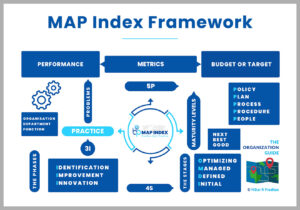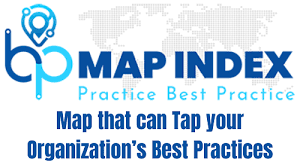Ask an impertinent question and you are on the way to the pertinent answer. — Jacob Bronowski
There are three important questions every organization must ask. They must be asking. But the question is the frequency and the intensity. How frequently we are asking? What is the intensity of ask? Not just once but they must constantly ask as the organization keeps growing. The faster business needs to grow, the competent we need to be in answering these critical questions. We may not have the right answer but we need to keep finding new answers to such old questions and the pursuit must continue relentlessly for finding something new.
- What to do?
- How to do?
- Who to do?
MAP Index framework is so designed that it critically focuses in asking these vitals questions for every practice. And it does so everytime a practice has to be graduated and to mature. Questioning is something that we have ceased to ask and even if we are asking we are not asking the right question, and not in the right manner. We are jumping to quick fix answers. How to create a culture of nurturing the art of asking questions? How to equip the managers to keep asking questions? How to master the art of questioning? The process of such a practice is made fundamental to the working of MAP Index framework.
Organizations are created to serve a fundamental purpose. Organization is designed to solve a problem. Organization is developed to perform. There is no performance without actual practice. Theories cannot produce results only practices do. The way organization does things. The way things happen in organization. It is the manner in which organizations work their way out of problems.
The key question is how an organization goes about in doing all such things in a more cohesive manner. There are strategies. There are structures. There are systems. These aspects are all connected and their interconnection matters. All these different organizations components work together to get the desired business results. Organization essentially is a complete system with inter-related parts. While we look at the system’s performance what matters is the way these parts work, if parts are malfunctioning, the system will eventually fail.
We don’t design a system for failure. The moot question remains. How does then a business leader design, develop and deploy a successful business organization?
There are different ways to go about in the management of business. There is no one way which we can term as the best way. If it would have been the case there won’t have been any innovation. It is the very idea that with new experiments and more explorations we create new thing and new ways of doing things. Everything evolves over time and with practice. The keyword is practice. The more we practice the better we perform. Organization has to keep performing on various aspects of its design to produce results. There are three important pillars to the execution of business design and organization development…
- Plan – It answers the “why” part
- Process & Procedure – It answers the “what” & “how” part
- People – It answers the “who” part
Organization’s device plans to achieve their business goals. The process of planning is about defining what all to be done. There are many organizations those who are excellent in planning but majorly fail during execution. Hence, the term “execution gap” which organizations must recognize and prepare to respond. How then to bridge these gaps during execution to make the plan work. The question doesn’t have an easy answer. The answers are in the way we analyze, act and adapt to things.
Organizations are a body of business processes at constant work. How to produce a product? How to procure the material? How to serve the customer? How to collect the receivables? How to hire the employee? How to fire the employee? How to check the quality? How to deliver the product? How to design the product? How to develop a new product? How to resolve the customer issues? How to evaluate an employee? How to set the sales target? How to schedule a production plan? How to pay the suppliers?
There are so many such questions on varied business processes in an organization. We cannot run a business organization without answering these key questions. Unlocking of business value happens with the use of these keys. Not just ones but we have to answer them many times as the situation demands and thing changes. These are not easy to answer the right way every time we are confronted with a new situation.
Processes show us the big picture but things actually have to be done on the ground at the smaller level. It is the step-by-step activities that need to be done to reach the destination. When we talk of a business process, for instance paying a supplier, we have given an order that the supplier has successfully executed. We have an agreed term to pay the supplier. We have to make the payment when we receive the bill for the executed order.
But the person incharge to make the payment have to check the order, see the delivery copy, get the purchase approval, get the quality approval, verify the billing details with the terms of agreement and once all these things matches, the payment can be processed. All these micro details are captured in the billing procedures. Unless the standard operating procedures are properly laid down, every time it will be done differently and different people will tend to do their way i.e. differently.
Even when we have the detailed procedures in place still things go wrong and it depends on the people involved and incharge. Do we have the right person at the right place? It’s a question which organizations have to answer and answer all the time. The plan often doesn’t change, the processes are usually set and the procedures are laid down, then only dimension which is dynamic in nature and subjective in feature is the people. It is the person incharge of discharging the stated things. It is their roles, their skill, their motivation to their accountability, are the various factors on which the efficient discharging depends.
Some organizations are brilliant in planning but falter when it comes to their processes to run the plan. Some organizations have excellent processes in place but falter when it comes to running the procedures on a regular basis. Some organizations have their plans, processes to procedures in perfect place but clinically fail when it comes to their people management skills.
Most organizations get deeply driven by their business plan and plans can only capture certain part of the overall programme to be executed. Many things are experienced and addressed during the process of execution. It is the manager incharge who has to be smart enough to solve problems and have to be adaptable to embracing the fast changing business situations and making better/faster decisions. The organization transforms and the business performs with consistency when these questions are proficiently answered, and we have a mechanism to keep answering them in an efficient manner. This is a culture that needs to be nurtured in the organization which cannot be borrowed or bought. The organization needs to create a space for it and build over time.












